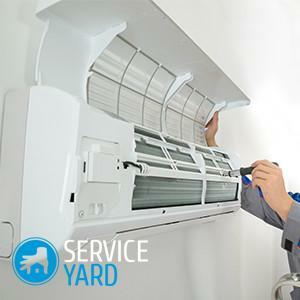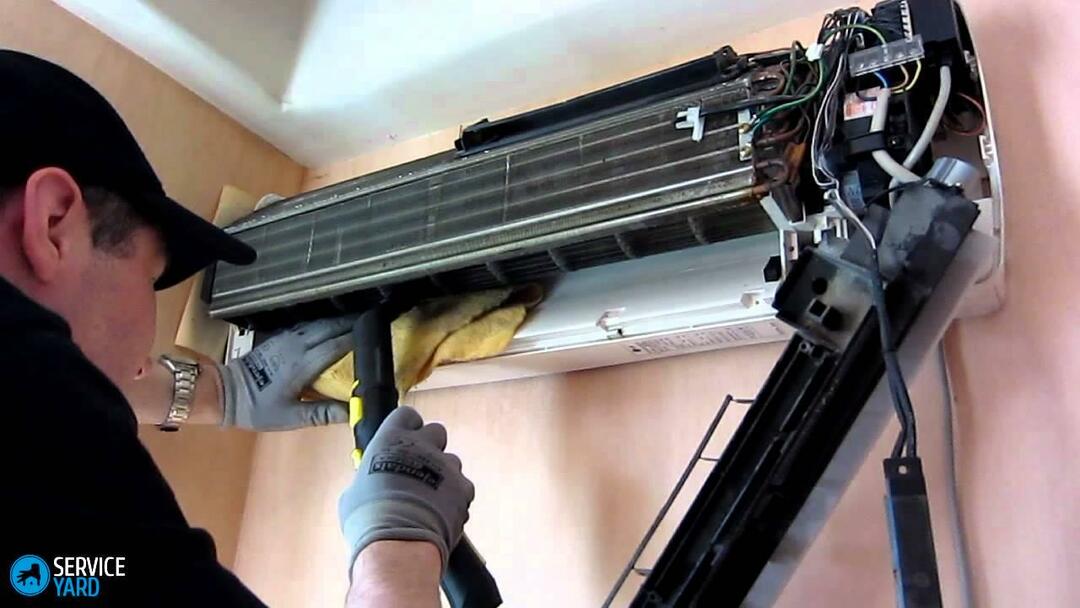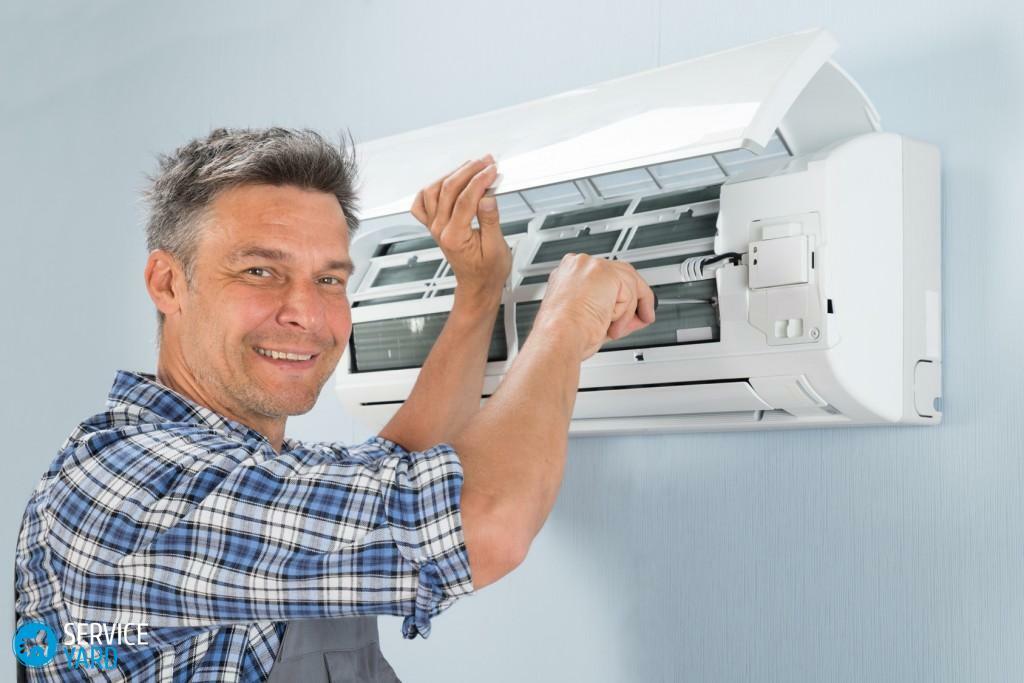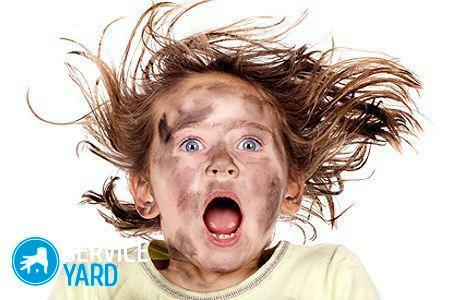
- How often should I clean?
- Cleaning the indoor unit of the air conditioner
- Cleaning the outdoor unit of the air conditioner
- How often should I clean?
- Cleaning the indoor unit of the air conditioner
- Cleaning the outdoor unit of the air conditioner
Modern climate technology has long ceased to be a luxury, and therefore, air conditioning can be found in almost every home. However, it should be remembered that the main components of such equipment, for example, evaporator, fan, radiator, require regular maintenance. For this, it is not necessary to call specialists, because cleaning the home air conditioner can be performed independently, if you adhere to the basic rules. What exactly - we will tell in this article.
to the contents ↑How often should I clean?
Each climate device is supplied by the manufacturer together with technical documentation, in which the recommended frequency of cleaning is indicated. Usually the frequency of these procedures depends on the overall degree of pollution in the room, but should be conducted at least once or twice a year.
Important! It is worth remembering that different structural elements need maintenance after a certain period of time. So, most often it is necessary to clean the air nets, which collect on their surface the main dust.
There are a number of signs that indicate that cleaning of the home air conditioner is necessary:
- Noise increase of the split system during operation.
- The appearance of unusual sounds - gurgling or squelching.
- Started to drip water from the indoor unit of the system.
- After turning on the air conditioner in the room there is an unpleasant smell.
The emergence of at least one of these symptoms suggests that the air conditioner does not fully fulfill its functions, and therefore needs a comprehensive cleaning, which can be done both on its own and with the help of qualified specialists.
Before cleaning the air conditioner at home yourself, you need to understand the design features of this device.
to the contents ↑Cleaning the indoor unit of the air conditioner
The indoor unit of the split system is located directly in the room and consists of the following components:
- filters;
- radiator;
- fan;
- heat exchanger - evaporator;
- drainage system - canal and bath.
Each of these systems requires periodic maintenance and cleaning from dust, debris and wool of pets.
Maintenance of air filters
The most frequent cleaning requires home air conditioner filters, which are represented by dust mesh. They prevent dust particles and small debris from getting to other components of the system. It is quite easy to carry out their maintenance, so any user will be able to cope with this task.
Important! Find the air filters you can right under the top cover of the indoor unit. Externally, these structural elements are represented by a fine mesh with plastic partitions. Depending on the model, there may be one to three filters in a block.
The cleaning procedure for these components is carried out according to the following algorithm:
- Disconnect the air conditioner from the power supply system.
- Lift the cover of the indoor unit and lock it in the up position.
- Remove the air filters.
- Clean the mesh surface of the part with a vacuum cleaner or brush.
- Rinse the filter under running cold water.
- Dry the strainer and reinstall it.
Important! Depending on the features of the air conditioner model you are using, the filters can be either flat or curved. However, this does not affect the cleaning method.
Cleaning the drainage system
The drainage system of the air conditioner consists of two main components:
- The tray is a tray that serves to collect liquid from a heat exchanger.
- Drainage tube - a channel that serves to remove the produced liquid from the room.
Cleaning the drainage system at home is done according to the following instructions:
- Remove the pallet by removing the plastic housing of the indoor unit and disconnecting the fastening connector.
- Clean the drain pipe by blowing it with air pressure from a vacuum cleaner or compressor.
- Rinse thoroughly under running water.

Important! Check that the drainage system is properly cleaned by filling it with 1.5 liters of clean water. If leaks are not detected, then the cleaning of the home air-conditioner is done carefully enough.
Fan
The fan of the climate control system is cleaned at home using the following procedure:
- After removing the strainer from the air conditioner, blow the fan using a vacuum cleaner that works on blowing.
- The blades of the parts are treated with a soap solution, which is applied to their surface with a long pile brush.
Important! To carefully handle all surfaces, turn the fan by hand.
- After 5 minutes, turn on the air conditioner, placing a film under the diffuser, to which all the contaminants in the system blow.
Important! The fan blades can be further processed with a special antibacterial agent. The modern household market offers a wide variety of cleaning compounds, which are designed specifically to service domestic split systems.
Cleaning the radiator and heat exchanger
At home, you can carry out only a surface cleaning of the radiator and heat exchanger, which does not assume their removal and detachment from the main structure. This procedure is performed according to the following instructions:
- Remove the top cover of the air conditioner.
- Unscrew the air filters and the front panel of the equipment.
- With a long nap brush, clean the radiator and evaporation equipment.
Important! Handle the device solely from the top to the bottom, as otherwise thin and fragile heat exchanger plates may be damaged.
- Pour 0.5 liters of antiseptic into the nebulizer.
- Switch on the air conditioner in recirculation mode with the lowest possible temperatures.
- Spray the antiseptic at a short distance from the radiator, near the suction zone of the split system.
Important! If you notice a mud film on the surface of the heat exchanger, it can be cleaned by using a steam cleaner. Preliminarily remove the layer of dry dust with a brush, and clean the parts of the device with an antiseptic.
to the contents ↑Cleaning the outdoor unit of the air conditioner
The external unit of the climate control system also needs periodic cleaning, but the dirt here does not contain fatty deposits, and therefore they are removed much faster and easier. Clean the outdoor unit of the air conditioner as follows:
- Disconnect the appliance from the mains.
- Remove the outer cover guard.
- Remove large debris with a vacuum cleaner or brush.
- Rinse the fan blades with any soapy solution.
- Use a hose or steam generator to clean the radiator.
Important! When cleaning the outdoor unit of the split system, make sure that the water does not get to the electrical components of the equipment.
In this article, we described how to properly and safely clean the air conditioner at home. Sincerely we hope that in the future the equipment will please you with a good and lasting work.
Modern climate technology has long ceased to be a luxury item, and therefore air conditioning can be found in almost every home. However, it should be remembered that the main components of such equipment, for example, evaporator, fan, radiator, require regular maintenance. For this, it is not necessary to call specialists, because cleaning the home air conditioner can be performed independently, if you adhere to the basic rules. What exactly - we will tell in this article.
to the contents ↑How often should I clean?
Each climate device is supplied by the manufacturer together with technical documentation, in which the recommended frequency of cleaning is indicated. Usually the frequency of these procedures depends on the overall degree of pollution in the room, but should be conducted at least once or twice a year.
Important! It is worth remembering that different structural elements need maintenance after a certain period of time. So, most often it is necessary to clean the air nets, which collect on their surface the main dust.
There are a number of signs that indicate that cleaning of the home air conditioner is necessary:
- Noise increase of the split system during operation.
- The appearance of unusual sounds - gurgling or squelching.
- Started to drip water from the indoor unit of the system.
- After turning on the air conditioner in the room there is an unpleasant smell.
The appearance of at least one of these symptoms suggests that the air conditioner does not fully fulfill its functions, and therefore needs a comprehensive cleaning, which can be done both by own efforts and with the help of qualified specialists.
Before cleaning the air conditioner at home yourself, you need to understand the design features of this unit.
to the contents ↑Cleaning the indoor unit of the air conditioner
The indoor unit of the split system is located directly in the room and consists of the following components:
- filters;
- radiator;
- fan;
- heat exchanger - evaporator;
- drainage system - canal and bath.
Each of these systems requires periodic maintenance and cleaning from dust, debris and wool of pets.
Maintenance of
air filters In the most frequent cleaning, home air conditioner filters are required, which are represented by dust mesh. They prevent dust particles and small debris from getting to other components of the system. It is quite easy to carry out their maintenance, so any user will be able to cope with this task.
Important! Find the air filters you can right under the top cover of the indoor unit. Externally, these structural elements are represented by a fine mesh with plastic partitions. Depending on the model, there may be one to three filters in a block.
The cleaning procedure for these components is carried out according to the following algorithm:
- Disconnect the air conditioner from the power supply system.
- Lift the cover of the indoor unit and secure it in the up position.
- Remove the air filters.
- Clean the mesh surface of the part with a vacuum cleaner or brush.
- Wash the filter under running cold water.
- Dry the strainer and reinstall it.

Important! Depending on the features of the air conditioner model you are using, the filters can be either flat or curved. However, this does not affect the cleaning method.
Cleaning the drainage system
The drainage system of the air conditioner consists of two main components:
- The tray is a bath that collects liquid from the heat exchanger.
- Drainage tube - a channel that serves to remove the produced liquid from the room.
Cleaning the drainage system at home is done according to the following instructions:
- Remove the pallet by removing the plastic housing of the indoor unit and disconnecting the fastening connector.
- Clean the drain pipe by blowing it with air pressure from a vacuum cleaner or compressor.
- Rinse thoroughly under running water.
Important! Check that the drainage system is properly cleaned by filling it with 1.5 liters of clean water. If leaks are not detected, then the cleaning of the home air-conditioner is done carefully enough.
Fan
The fan of the climate control system at home is cleaned according to the following algorithm:
- After removing the strainer from the air conditioner, blow the fan using a vacuum cleaner that works on blowing.
- Blades of the parts are treated with a soap solution, which is applied to their surface with a long pile brush.
Important! To carefully handle all surfaces, turn the fan by hand.
- After 5 minutes, turn on the air conditioner, placing a film under the diffuser, to which all the contaminants in the system blow.
Important! The fan blades can be further processed with a special antibacterial agent. The modern household market offers a wide variety of cleaning compounds, which are designed specifically to service domestic split systems.
Cleaning the radiator and heat exchanger
At home, you can only carry out a surface cleaning of the radiator and heat exchanger, which does not assume their removal and disconnection from the main structure. This procedure is performed according to the following instructions:
- Remove the top cover of the air conditioner.
- Unscrew the air filters and the front panel of the equipment.
- With a long nap brush, clean the radiator and evaporation equipment.
Important! Handle the device solely from the top to the bottom, as otherwise thin and fragile heat exchanger plates may be damaged.
- Transfer 0.5 liters of antiseptic to the nebulizer.
- Switch on the air conditioner in recirculation mode with the lowest possible temperatures.
- Spray the antiseptic at a short distance from the radiator, near the suction zone of the split system.
Important! If you notice a mud film on the surface of the heat exchanger, it can be cleaned by using a steam cleaner. Preliminarily remove the layer of dry dust with a brush, and clean the parts of the device with an antiseptic.
to the contents ↑Cleaning the outdoor unit of the air conditioner
The outdoor unit of the climate control system also needs periodic cleaning, but the contaminants here do not contain fatty deposits, and therefore are removed much more quickly and easily. Clean the outdoor unit of the air conditioner according to the following instructions:
- Disconnect the device from the mains.
- Remove the outer cover guard.
- Remove large debris with a vacuum cleaner or brush.
- Rinse the fan blades with any soapy solution.
- Use a hose or steam generator to clean the radiator.
Important! When cleaning the outdoor unit of the split system, make sure that the water does not get to the electrical components of the equipment.
In this article, we described how to properly and safely clean the air conditioner at home. Sincerely we hope that in the future the equipment will please you with a good and lasting work.



